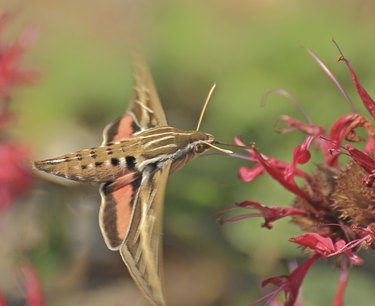
Just like tomatoes (Lycopersicon esculentum), tomato-eating pests come in a variety of sizes and appearances. While most of them concentrate on the leaves, one prefers burrowing into a tomato's fruit and devouring it from the inside out. Another scrapes large, shallow patches in the fruit's surface. If they find your plants, your much-anticipated harvest may be ruined. Fortunately, ridding tomatoes of these unwanted guests is possible with strictly organic measures.
Tomato Fruitworms
Video of the Day
Tomato fruitworms hatch from reddish-ringed, white eggs deposited on both surfaces of the upper leaves. Spring-hatched worms burrow into developing tomatoes measuring 3/4 to 2 inches in diameter. Those born later the growing season attack ripe fruit. All of them fill the wet burrows with dark waste and shed skins.
Video of the Day
Fruitworm Control
For organic tomato fruit worm control, spray the infested tomatoes with ready-to-use, microbial Bacillus thuringiensis var. kurstaki spray. Monitor the plants for eggs beginning in early spring and spray when they begin to hatch.
Bt works best on the young worms eating it on the the surface of sprayed tomatoes. It paralyzes and ruptures their digestive systems. The worms stop eating right away, but it may be three days before they die.
Treat the tomatoes after sundown so ultraviolet rays won't damage the microbes and rain won't wash them from the plants. Spray until the Bt solution drips from both sides of the leaves and the developing fruit. Reapply after heavy rain and every five to seven days, or at the label's suggested intervals, to kill later-hatching worms.
Wear long pants, a long-sleeved shirt, gloves, safety goggles and a respiratory mask, and follow the label's instructions when handling pesticides.
Tomato Hornworms
The Godzillas of tomato pests, pale-green tomato hornworms grow up to 4 inches long and as thick as thumbs. While they primarily target leaves, they also bite large gouges in the fruit.
Active between mid- and late summer, hornworms eat for up to a month before dropping to the soil to pupate. Without treatment, they may completely defoliate their hosts.
Hornworm Control
Manage an early hornworm infestation by handpicking and drowning the pests in soapy water. To find them, look for heavily chewed leaves, gouged fruit or their dark-green waste. The worms often shelter beneath leaves on stems close to recent feeding sites.
If any hornworms are covered in tiny white cylinders, let them be. They're toting the cocoons of predatory braconid wasp larvae that have already devoured them from the inside. After the cocoons release the newly matured wasps to deposit their eggs in other hornworms, their dying hosts shrivel up and fall from the plants.
Lure braconid wasps to the tomato patch with pollen- or nectar-producing, shallow-faced flowers such as perennial sweet alyssum (Lobularia maritima), suitable for U.S. Department of Agriculture plant hardiness zones 5 through 9. Other good choices are annuals dill (Anethum graveolens) and cilantro (Coriandrum sativum)
Ready-to-use Bt spray also kills hornworms when applied as you would to control fruitworms.
- UC Statewide IPM Online: Tomatoes
- UC Statewide IPM: Tomato Fruitworms
- University of Illinois Extension: Homeowner's Column -- Using Bacillus Thuringiensis Effectively
- UC Statewide IPM: Pesticide Information -- Active Ingredient, Bacillus Thuringiensis Spp. Kurstaki
- UC Statewide IPM Online: Tomato Hornworm
- Toxic Free NC: Organic Solutions for Tomato Hornworms
- Missouri Botanical Garden: Lobularia Maritima
- Missosuri Botanical Garden: Anethum Graveolens
- Missouri Botanical Garden: Coriandrum Sativum
- Texas A&M AgriLife Extension: Tomato Problem Solver